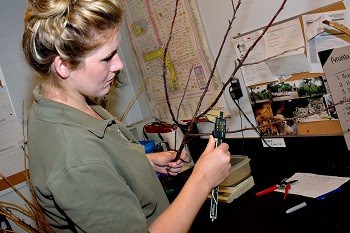Week-long hiring event February 18-24 to fill wide variety of roles VAUGHAN, ON (Feb. 6,…

TORONTO ZOO IS ‘BROWSING’ THE IMPORTANCE OF NUTRITIONAL RESEARCH

Photo Credit: Toronto Zoo
In 2015 Toronto Zoo’s Wildlife Nutrition Centre (WNC) produced, harvested, and distributed approximately 20,000 kilograms of browse material, which is vegetation, such as twigs and young shoots, to the browsing zoo herbivores. This large amount is harvested annually from two established “browse farms” near by. The browse plants produced for harvesting include apple (Malus spp.), poplar (Populus spp.) and several varieties of willow (Salix spp.). Browse is processed as whole branches, either as fresh or ensiled. To make browse silage, WNC staff compresses fresh branches into large air tight drums in which anaerobic fermentation is acidifying it and this silage is offered to herbivores in the fall, winter, and early spring, when trees are dormant and leaves are not abundant.
The provision of browse is an important aspect of the husbandry of browsers and herbivorous animals. Within the existing dietary regimes, most animals prefer browse more than other food items. The form and structure of tree branches allows for expression of natural behaviours as animals search and manipulate the branches while selecting edible portions. Browse can be considered a more natural dietary item due to its nutritional profile and physical structure. When animals are provided with opportunities to interact with items that provide stimulation there is a decrease in unusual or unwanted stereotypic behaviour. An example of unusual behaviour in great ape species is the occurrence of regurgitation and re-ingestion of food. This activity can be reduced or eradicated with a significant supply of browse to these primate’s diets.
Over the course of the last decade the Toronto Zoo’s WNC has been involved in browse research projects in conjunction, with the fulfilment of an MSc-degree by thesis with the University of Guelph. Over the last few years, student and Wildlife Nutrition Intern, Sarra Gourlie, has focused on the edible quantity and quality of apple browse, which is provided daily to the Western Lowland gorilla troop at the Zoo. The edible portions of an apple branch (i.e. the leaves, twigs, and bark) were analyzed for their nutritional profiles. Additionally, equations used to predict the amount of each of these three edible portions were constructed, to help make estimates about the ‘serving size’ of these consumables. And finally, a clinical approach was undertaken using a comparative species to assess whether the leaves and bark could elicit changes that alter the health of exotic herbivores. Through this research, it was demonstrated that apple browse is a safe and healthy food item and may have an ability to improve serum cholesterol concentrations when consumed at levels that are currently being fed to the Western Lowland gorillas. In human health blood cholesterol levels are regularly utilized to assess health as marker for the risk of developing various disease states such as cardiovascular disease. In zoos cardiovascular disease is one of the major causes of mortality in great ape species. The results of this study were very exciting and will assist in improving the diets, well-being, and health of browsing animals at the Toronto Zoo.
In addition to the results of the apple browse research, the study established a scientific framework that others may use to test the quality and suitability of a browse plant to an exotic animal species. The underlying goal of the current browse research is to evolve the perception of browse as more than a behavioural enrichment item but as an essential vector for nutrients and novel compounds that can influence health. A systematic approach to evaluating browse plants, may assist in correlating behavioural, morphological, and physiological changes in herbivores consuming browse. Ultimately, improving the understanding of how components of the diet alter the health and wellbeing of animals in zoos could shed light on the restrictions and the flexibility of animal’s digestive capabilities in the wild. With foraging ranges of many free ranging herbivores being diminished by anthropogenic means, gaining a foothold on the inner workings of these animals has never been more important. The Wildlife Nutrition Centre continues with browse feeding and in the coming years will utilize this framework to scientifically assess willow browse
CLICK HERE to learn more about the Zoo’s Nutrition Research.



This Post Has 0 Comments